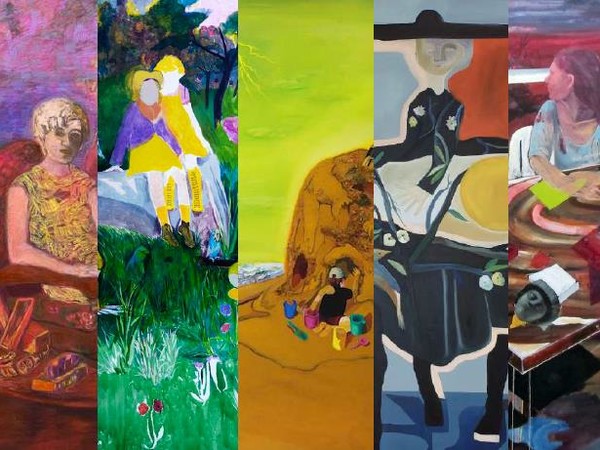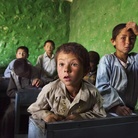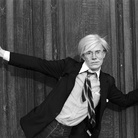If It Is Untouchable It Is Not Beautiful

If It Is Untouchable It Is Not Beautiful, Monitor Rome Lisbon
From 14 Febbraio 2019 to 30 Marzo 2019
Rome
Place: Monitor Rome Lisbon
Address: via Sforza Cesarini 43A
Telefono per informazioni: +39 06 3937 8024
E-Mail info: monitor@monitoronline.org
Official site: http://www.monitoronline.org
Beauty should be something that is tangible. Something which finds its place in-between our senses and which insinuates itself in our thoughts for a long time. A beautiful thing does not have to be necessarily perfect - imperfection itself can be a repository of meaning and of extraordinary beauty. Skewed perspectives, layering of colour, flawed but captivating foreshortening: over the centuries, painting has been the repository for all these things, passing through the ages epically, amongst suicides and theatrical murders, all the while staying true to itself and all its contradictions.
This is the premise of the first show of the year at Monitor, If it is untouchable it is not beautiful, an investigation into the work of five artists based in Italy: Maddalena Tesser, Giuliana Rosso, Alice Visentin, Aryan Ozmaei and Paola Angelini. The exhibition prompts a dialogue between their work, comparing and contrasting their differences, analogies and approaches to painting as a medium in all its entirety.
Maddalena Tesser (Vittorio Veneto, 1992)’s paintings are inhabited by female figures, immersed in suspended and mysterious atmospheres. They seem to ooze Venice and the paintings of its palaces. Faces are caught in the oblivion of uncertainty, at times detailed, at times barely visible, while at others absent. Tesser’s use of colour is striking and most stands out from her work. Dissonant, acidic, sometimes almost violent to then become liquid once more, veiled, and untouchable as in Risveglio (Awakening), 2018. Tesser’s obsession with objects, their presence and their details is evident in La Teoria delle Vergini (Solo) (The Theory of Virgins (Only) ), 2017, where the pavement and ceiling almost collapse onto the figure without crushing it, but simply brushing against its outline.
Giuliana Rosso (Turin, 1992) works principally on canvas and paper, as well as touching upon sculpture. She affirms she is investigating “interiority and its shadows, the most hidden corners of our conscience, of objects and things without sense as a place from which unusual realities emerge”. Rosso favours portraying adolescents or figures which recall that determined moment in one’s life, when everything is undefined, on its way to being formed, rich of possibilities but equally inhabited by fears and misgivings. Her paintings convey a state of mind and emotions which are conducive to an almost ancestral feeling, made up of demons, witchcraft, sayings and proverbs, fairytales and premonitions, all rendered in a decidedly noir vein and a knowing structure of the canvas in a well defined and apparent naivitè as seen in her Il Gioco (The Game) or in I Metafisici (The Metaphysicians).
Alice Vicentin (Turin, 1993) is another promising young artist from Turin. Her paintings are large, titanic, made up of aggressive but never grating colours. They are tonal, devoid of ornament or nuances: explosions of blues, reds, and yellows, together with ample and imposing silhouettes which recall jugglers, acrobats and clumsy soldiers at a king’s court. The works are not disquieting, rather the opposite. It’s as though they inhabit a golden dimension, they express steadiness, calm, and immutability, even though - if observed carefully - they appear wrapped in a distant, muted veil of melancholy.
Aryan Ozmaei (Teheran, 1976) has been immersed in the complex and tormented culture of Florence for the past 15 years. Her paintings carry the inheritance of a relatively close but different world. The Iran of her adolescence, its domestic spaces and changing landscapes. All of this is seen through windows which give onto the possibility of a hypothetical future, suspended in memory? In the present? The colours of her paintings are a kaleidoscope of brushstrokes - layered, nuanced, and rethought many times over, culminating in a final determined layout.
Paola Angelini (San Benedetto, 1983)’s paintings are complex, multilayered, made up of various readings which blend into one other without ever losing their individuality. In Angelini’s early work, the main action often takes place in the background, even when they appear to be monochrome. In her new work, each part of the painting is equally important and articulated. As the artist herself states: “There is a necessity in painting, where everything is circumscribed by the borders of the canvas, and where everything converges as though poured in. This necessity is moved by a logic made up of images which needs to find the right language to contain a sustained mental and conscious work, which holds at its heart the creation of new notions.” On the day sacred to lovers, Saint Valentine’s Day, let’s all meet in front of colourful walls, which are rich of images, stories and worlds.
This is the premise of the first show of the year at Monitor, If it is untouchable it is not beautiful, an investigation into the work of five artists based in Italy: Maddalena Tesser, Giuliana Rosso, Alice Visentin, Aryan Ozmaei and Paola Angelini. The exhibition prompts a dialogue between their work, comparing and contrasting their differences, analogies and approaches to painting as a medium in all its entirety.
Maddalena Tesser (Vittorio Veneto, 1992)’s paintings are inhabited by female figures, immersed in suspended and mysterious atmospheres. They seem to ooze Venice and the paintings of its palaces. Faces are caught in the oblivion of uncertainty, at times detailed, at times barely visible, while at others absent. Tesser’s use of colour is striking and most stands out from her work. Dissonant, acidic, sometimes almost violent to then become liquid once more, veiled, and untouchable as in Risveglio (Awakening), 2018. Tesser’s obsession with objects, their presence and their details is evident in La Teoria delle Vergini (Solo) (The Theory of Virgins (Only) ), 2017, where the pavement and ceiling almost collapse onto the figure without crushing it, but simply brushing against its outline.
Giuliana Rosso (Turin, 1992) works principally on canvas and paper, as well as touching upon sculpture. She affirms she is investigating “interiority and its shadows, the most hidden corners of our conscience, of objects and things without sense as a place from which unusual realities emerge”. Rosso favours portraying adolescents or figures which recall that determined moment in one’s life, when everything is undefined, on its way to being formed, rich of possibilities but equally inhabited by fears and misgivings. Her paintings convey a state of mind and emotions which are conducive to an almost ancestral feeling, made up of demons, witchcraft, sayings and proverbs, fairytales and premonitions, all rendered in a decidedly noir vein and a knowing structure of the canvas in a well defined and apparent naivitè as seen in her Il Gioco (The Game) or in I Metafisici (The Metaphysicians).
Alice Vicentin (Turin, 1993) is another promising young artist from Turin. Her paintings are large, titanic, made up of aggressive but never grating colours. They are tonal, devoid of ornament or nuances: explosions of blues, reds, and yellows, together with ample and imposing silhouettes which recall jugglers, acrobats and clumsy soldiers at a king’s court. The works are not disquieting, rather the opposite. It’s as though they inhabit a golden dimension, they express steadiness, calm, and immutability, even though - if observed carefully - they appear wrapped in a distant, muted veil of melancholy.
Aryan Ozmaei (Teheran, 1976) has been immersed in the complex and tormented culture of Florence for the past 15 years. Her paintings carry the inheritance of a relatively close but different world. The Iran of her adolescence, its domestic spaces and changing landscapes. All of this is seen through windows which give onto the possibility of a hypothetical future, suspended in memory? In the present? The colours of her paintings are a kaleidoscope of brushstrokes - layered, nuanced, and rethought many times over, culminating in a final determined layout.
Paola Angelini (San Benedetto, 1983)’s paintings are complex, multilayered, made up of various readings which blend into one other without ever losing their individuality. In Angelini’s early work, the main action often takes place in the background, even when they appear to be monochrome. In her new work, each part of the painting is equally important and articulated. As the artist herself states: “There is a necessity in painting, where everything is circumscribed by the borders of the canvas, and where everything converges as though poured in. This necessity is moved by a logic made up of images which needs to find the right language to contain a sustained mental and conscious work, which holds at its heart the creation of new notions.” On the day sacred to lovers, Saint Valentine’s Day, let’s all meet in front of colourful walls, which are rich of images, stories and worlds.
SCARICA IL COMUNICATO IN PDF
paola angelini ·
aryan ozmaei ·
marco gualazzini ·
giuliana rosso ·
maddalena tesser ·
alice visentin ·
paola angelini aryan ozmaei giuliana rosso maddalena tesser alice visentin
COMMENTI

-
 Dal 31 gennaio 2024 al 04 maggio 2025
Fermo | Palazzo dei Priori
Dal 31 gennaio 2024 al 04 maggio 2025
Fermo | Palazzo dei Priori
-
 Dal 20 dicembre 2024 al 04 maggio 2025
Fermo | Palazzo dei Priori
Dal 20 dicembre 2024 al 04 maggio 2025
Fermo | Palazzo dei Priori
-
 Dal 20 dicembre 2024 al 04 maggio 2024
Gorizia | Palazzo Attems Petzenstein
Dal 20 dicembre 2024 al 04 maggio 2024
Gorizia | Palazzo Attems Petzenstein
-
 Dal 18 dicembre 2024 al 18 dicembre 2024
Venezia | Museo Correr
Dal 18 dicembre 2024 al 18 dicembre 2024
Venezia | Museo Correr
-
 Dal 14 dicembre 2024 al 02 marzo 2025
Palermo | Palazzo Abatellis
Dal 14 dicembre 2024 al 02 marzo 2025
Palermo | Palazzo Abatellis
-
 Dal 12 dicembre 2024 al 23 febbraio 2025
Roma | Palazzo Altemps
Dal 12 dicembre 2024 al 23 febbraio 2025
Roma | Palazzo Altemps


